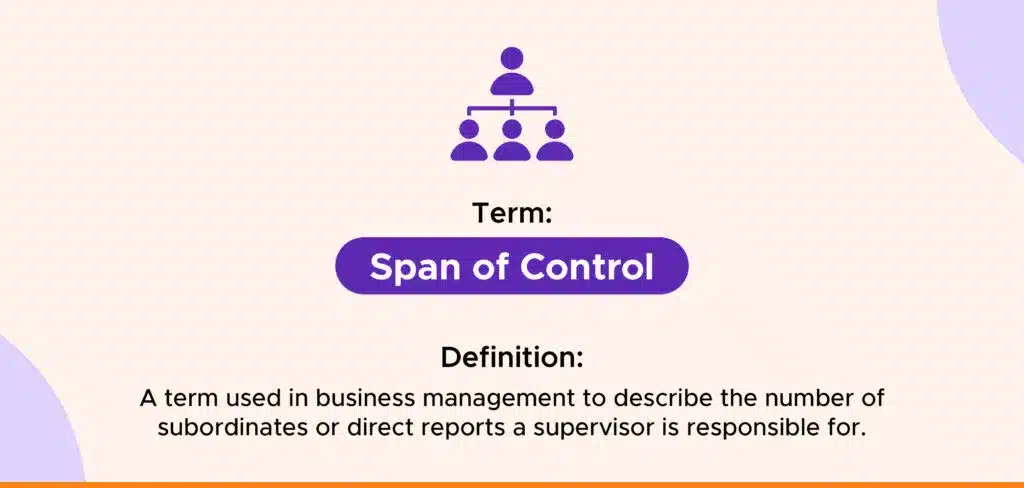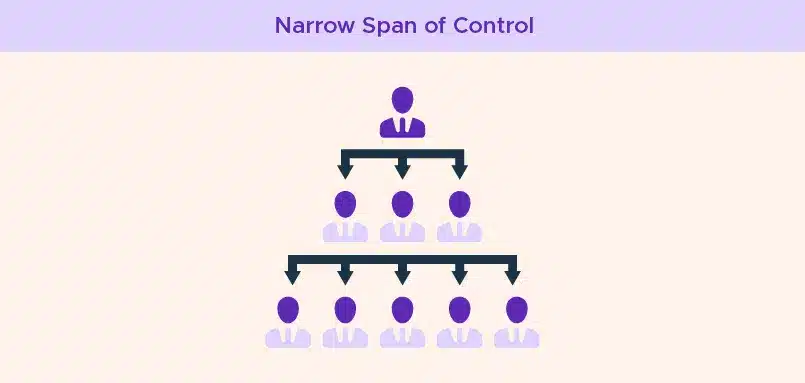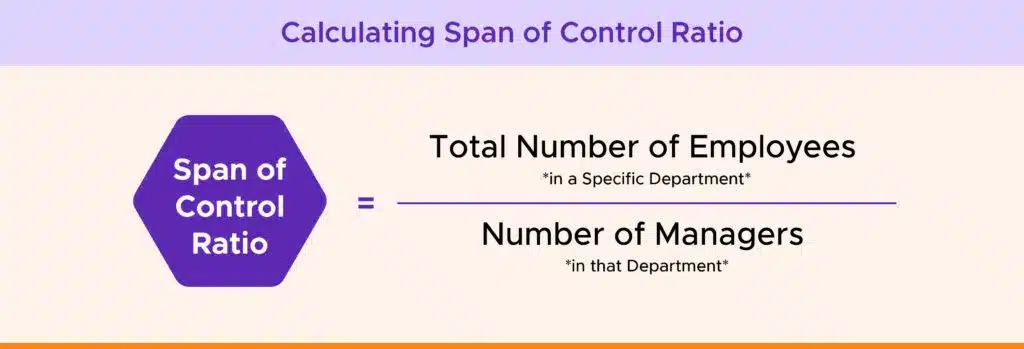Effectively managing an organization involves more than just overseeing tasks—it’s also about ensuring that each manager can handle their team efficiently. The span of control, which determines the number of direct reports a manager is responsible for, is a critical factor in this equation, influencing team dynamics, productivity, and overall success.
In this deep dive, we’ll explore the concept of span of control, its implications, and how to determine the ideal number of direct reports for your organization.
Whether you’re aiming to improve your organizational setup or seeking to better understand managerial responsibilities, this guide will provide valuable insights into optimizing your span of control for better results.
What is Span of Control and Why Should You Care?
Span of Control Definition
Span of Control refers to the number of direct reports a manager oversees. It defines the scope of a manager’s supervision and significantly impacts organizational efficiency and effectiveness.
A well-managed span of control ensures an optimal balance between too many or too few direct reports, influencing managerial effectiveness, communication, adaptability, and workload distribution.

Why is Span of Control Important?
The span of control isn’t just about reporting lines; it significantly impacts your employees’ experience and your organization’s success. Here’s how:
✅ Managerial Effectiveness
The right span of control allows managers to be effective leaders. If a manager has too many people to oversee, they might struggle to provide proper guidance and support to each team member. On the other hand, with the right number of people, managers can offer more personalized attention, leading to better employee development and performance.
Suggested read: 12 Effective Performance Evaluation Methods
🗣️ Communication Dynamics
Clear communication is vital for any team. The span of control influences how information flows. With a balanced SOC, communication channels are streamlined, ensuring everyone gets the information they need, when they need it.
🧠 Adaptability and Innovation
Think about it – the fewer employees in the layers of management, the faster decisions can be made. This agility is crucial in the business environment we are in today. Flatter structures with wider spans of control can also encourage a more innovative culture as employees have more autonomy and ownership over their work.
🫂 Workload and Delegation
It directly affects workload distribution. A manager with a large number of subordinates might struggle to delegate tasks effectively, leading to burnout for both the manager and the team. With a well-defined SOC, managers can delegate tasks appropriately, empowering employees and fostering a sense of ownership.
What are the Types of Span of Control in Organizational Structure?
There are two main approaches to span of control: wide spans (flat structures) and narrow spans (tall structures).
Wide Span of Control (Flat Structures)

A wide span of control refers to a management structure in which a single manager oversees a large number of employees. This approach is often found in flatter organizations with fewer layers, allowing for more efficient communication and faster decision-making.
What are the Advantages of a Wide Span of Control?
👉 Agility and Speed: Fewer management layers mean faster decision-making and quicker response to market changes.
👉 Cost Efficiency: Reduced management overhead due to fewer supervisors.
👉 Employee Empowerment: Increased autonomy for employees, fostering innovation and employee satisfaction.
What are the Disadvantages of a Wide Span of Control?
👉 Manager Overwhelm: Managers may struggle to provide adequate support to a large number of subordinates.
👉 Limited Development: Reduced opportunities for employee coaching and development.
👉 Communication Challenges: Difficulty in ensuring effective information flow across a larger team.
Narrow Span of Control (Tall Structures):

A narrow span of control is a management structure where a manager oversees a small number of direct reports, typically 3 to 7 employees. This setup is used when tasks are complex and require close supervision, or when employees need frequent guidance and support.
It allows managers to provide more personalized attention, regular feedback, and detailed oversight, enhancing communication and employee development.
Advantages of Narrow Span of Control
👉 Closer supervision and development: Managers provide more focused guidance, benefiting new hires and complex projects.
👉 Improved communication: Fewer management layers lead to faster decision-making and clearer information flow.
Disadvantages of Narrow Span of Control
👉 Slower decision-making: Multiple approval levels can delay processes.
👉 Higher costs: More managers increase overhead expenses.
👉 Potential for micromanagement: Close supervision can stifle creativity and morale.
The optimum span of control depends on your specific needs and context, and other various factors. Let’s see how you can calculate it!
How Do You Calculate Span of Control?
The Span of Control ratio is calculated by dividing the number of direct reports by the number of managers. Here’s the simple formula:
Span of Control Ratio= Total Number of Employees *in a Specific Department* / Total Number of Managers *in that Department*
Let’s consider a company with 50 employees and 5 managers. To calculate the span of control, we can use the formula:
In this case:
- Number of Employees: 50
- Number of Managers: 5
Span of Control= 50/5 =10:1
This means that each manager in this company is responsible for overseeing an average of 10 employees.
What is the Ideal Span of Control Ratio?
An article by McKinsey recommends not having a one-size-fits-all ideal span of control ratio. Instead, they suggest a more nuanced approach based on the complexity of the manager’s work. They identified five managerial archetypes (or supervisor archetypes):
1. Player Archetype (3-5 reports): These managers handle complex and unique tasks that demand extensive experience, such as strategic planning or consulting roles.
2. Coach Archetype (6-7 reports): Managers in this category balance individual tasks with supporting their team through established processes. This archetype is often found in roles like marketing analytics management.
3. Supervisor Archetype (8-10 reports): Overseeing standardized work with some degree of individual responsibility characterizes this archetype. Examples include accounting managers or senior finance VPs.
4. Facilitator Archetype (11-15 reports): Managers in this category handle highly standardized tasks with minimal individual contribution. Typical roles might include accounts payable or receivable managers.
5. Coordinator Archetype (15+ reports): This archetype is focused solely on managing routine and automated tasks, often found in roles like call center management.
This framework helps determine the optimal span of control based on the specific skills and experience required for the manager’s team, not an arbitrary number.
Now that we’ve seen what the optimal span of control could be, let’s look at what factors influence this decision.
What Factors Influence the Ideal Span of Control?
Several key factors influence the ideal span of control for an organization:
1. Nature of the Work
The complexity and type of tasks performed by employees play a major role. Simple, repetitive tasks can allow for a wider span of control, while complex or specialized tasks that require close supervision necessitate a narrower span.
2. Managerial Ability
The skills and capabilities of the manager are critical. Managers with strong leadership, decision-making, and communication skills can effectively oversee a larger number of employees. Conversely, less experienced managers may require a narrower span to provide adequate support.
3. Employee Competence
The skills and experience of employees also influence the span of control. Highly skilled and self-sufficient employees require less supervision, allowing for a wider span, whereas less experienced employees may need more guidance and support.
4. Organizational Structure
The overall size and structure of the organization impact the ideal span of control. Larger organizations may have a narrower span due to increased complexity, while smaller organizations can often accommodate a wider span.
5. Time Available for Supervision
Managers at higher levels often have less time for direct supervision due to their broader responsibilities. As a result, the span of control may need to be narrower at these levels to ensure effective oversight.
6. Degree of Decentralization
Organizations that decentralize decision-making may allow managers to supervise more employees. In contrast, centralized organizations, where executives make most decisions, may require a narrower span of control.
7. Organizational Culture
The culture of the organization influences how teams operate. Cultures that promote autonomy and empowerment may support a wider span of control, whereas more hierarchical cultures may necessitate a narrower span.
8. Job Function and Industry
Different industries and job functions have varying requirements for supervision. For example, labour-intensive roles may allow for a higher span of control, while knowledge-based roles may require a lower span to ensure quality oversight.
⚙️ How to Optimize the Span of Control for Your Organization?
Now that you understand the factors influencing your ideal Span of Control, it’s time to translate that knowledge into action. Here’s a clear roadmap to optimize the span of control for your organization.
Step 1: Conduct a Span of Control Analysis
The first step is to gain a clear picture of your current span of control situation. This involves:
1.1: Mapping Your Structure
Visually map your entire organizational structure, including all departments, teams, and individual roles. This can be done using software tools or a simple whiteboard exercise.
People analytics tools like Peoplebox let you easily visualize the organizational structure with org charts by drilling down into individual profiles based on over 50 key metrics.

1.2: Workload Assessment
Go beyond numbers and assess the actual workload each team and manager handles. Consider factors like project complexity, meeting schedules, and individual responsibilities. Utilize surveys or one-on-one discussions to gather insights directly from employees and managers.
1.3: Calculating Span of control Ratios
Don’t settle for a single company-wide span of control ratio. Calculate the span of control ratio for each department or team individually using the formula shared at the beginning of this article, or you can see the image below.

Step 2: Evaluate the Effectiveness
Numbers tell part of the story, but the real impact lies in how the span of control is affecting your workforce. Here’s how to assess effectiveness:
2.1: Employee Engagement Surveys
Gauge employee sentiment through engagement surveys. Ask targeted questions about job satisfaction, workload, supervision, and decision-making speed. Analyze responses to identify trends related to SOC. For example, high workload complaints might suggest a team with a manager overseeing too many direct reports.
Here’s a list of questions you can ask:
✔️ How satisfied are you with the level of support you receive from your manager?
✔️ Do you feel you have enough time to complete your tasks effectively?
✔️ How often do you receive feedback from your manager on your performance?
✔️ Do you feel empowered to make decisions related to your work?
✔️ How would you rate the communication within your team?
Also read: 30+ Stay Interview Questions You Can Ask To Retain People
Performance Review Platform
Get a glimpse of how Peoplebox make performance reviews painless, actionable and fair
A Guide To Conducting Employee Engagement Surveys
2.2: Performance Reviews
Analyze trends in team productivity, quality of work, and individual performance with performance reviews. Look for correlations between span of control and performance.
Are teams with a narrower span of control consistently exceeding expectations, or is there a lack of clear direction and guidance?
2.3: Communication Audits
Evaluate how information flows within teams and across departments. Are there communication silos hindering collaboration, or is information readily available to everyone who needs it?
Step 3: Restructure When Necessary
Based on your analysis, it might be time to adjust your structure:
3.1: Redistributing Direct Reports
If managers are overloaded, consider redistributing direct reports among teams to achieve a more balanced workload. This might involve shifting responsibilities or creating cross-functional teams.
3.2: Creating New Management Positions
For teams with highly complex tasks or less experienced employees, creating new management positions might be necessary to provide adequate support. This allows for closer supervision and more focused attention on individual development.
Step 4: Invest in Management Development
Equipping your managers with the skills to handle their span of control effectively is crucial for long-term success. Here’s how:
4.1: Delegation Training
Provide managers with practical training on effective delegation techniques. This includes:
👉 Identifying tasks that can be delegated
👉 Matching tasks to employee skillsets
👉 Setting clear expectations for deliverables
4.2: Communication Skills Workshops
Equip managers with the communication skills they need to keep their teams informed, engaged, and aligned with goals. This includes active listening, providing constructive feedback, and fostering open communication channels.
4.3: Leadership Development Programs
Invest in leadership development programs that hone managers’ ability to motivate, inspire, and guide their teams. This can cover topics like conflict resolution, leadership styles, performance management, and building high-performing teams.
Throughout this process, technology can be your greatest ally. Utilizing tools like HRIS, engagement surveys, and performance management software enables data-driven decision-making and cultivates an environment of transparent communication.
Suggested read: 30+ Leadership SMART Goals Examples To Unlock Success
How Can You Support Managers with a Narrow or Overextended Span of Control?
To support managers with a narrow or overextended span of control, consider these strategies:
✅ Assess Workload: Regularly evaluate the manager’s workload and team dynamics to identify areas where their span of control is either too broad or too limited.
✅ Delegate Wisely: Ensure tasks and responsibilities are appropriately delegated. Empower team members with autonomy while relieving managers of non-essential tasks.
✅ Enhance Communication: Improve communication channels and provide tools for efficient team coordination. This helps managers keep track of their team’s progress and challenges more effectively.
✅ Provide Training: Offer leadership and time management training to help managers handle their span of control more effectively.
✅ Adjust Team Structure: If necessary, restructure teams to better align with managers’ capabilities. This could involve creating specialized roles or redistributing team members.
✅ Leverage Technology: Utilize project management tools and performance management software to streamline processes and reduce the manual workload on managers.
🥨 Building a Thriving Workforce with Peoplebox
Peoplebox, the most-integrated OKR, performance management, and people analytics software, empowers strategic workforce decisions through its intuitive platform.
Peoplebox seamlessly integrates with your existing human resources systems, keeping your data up-to-date and enabling effortless goal-setting and performance management. Build effective workforce plans with scenario modelling, and leverage real-time employee insights to optimize your span of control.
Ready to build a high-performing organization? Contact us today to see how we can help!
Performance Review Platform
Get a glimpse of how Peoplebox make performance reviews painless, actionable and fair






